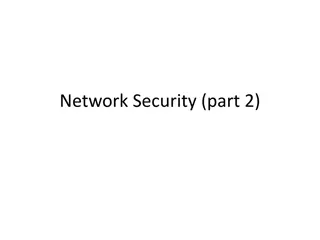
Securing Wireless Networks: Best Practices for Network Defense and Protection
Implementing strong security measures is essential for securing wireless networks against unauthorized access and data breaches. Encryption, network segmentation, strong authentication, and intrusion detection/prevention are key strategies to safeguard the confidentiality, integrity, and availability of data transmitted over wireless communication channels.
Download Presentation

Please find below an Image/Link to download the presentation.
The content on the website is provided AS IS for your information and personal use only. It may not be sold, licensed, or shared on other websites without obtaining consent from the author. If you encounter any issues during the download, it is possible that the publisher has removed the file from their server.
You are allowed to download the files provided on this website for personal or commercial use, subject to the condition that they are used lawfully. All files are the property of their respective owners.
The content on the website is provided AS IS for your information and personal use only. It may not be sold, licensed, or shared on other websites without obtaining consent from the author.
E N D
Presentation Transcript
1213 Network Defense Lecture 4 Part 2 # Securing Your Network Securing Your Network - Lecture 1 King Saud University Applied Studies and Community Service 1213
Securing Wireless Networks Securing wireless networks involves implementing measures to protect the confidentiality, integrity, and availability of data transmitted over wireless communication channels. This includes safeguarding against unauthorized access, interception of data, and other security threats. Common security measures for securing wireless networks include: : . . 1. Encryption: 2. Network Segmentation: 3. Strong Authentication: 4. Intrusion Detection and Prevention: By implementing these security measures, organizations can effectively secure their wireless networks and mitigate the risk of unauthorized access and security breaches. . - Lecture 1 King Saud University Applied Studies and Community Service 1213
Encryption: Implementing strong encryption protocols such as WPA2 (Wi-Fi Protected Access 2) or WPA3 to encrypt data transmitted over the wireless network, preventing unauthorized users from intercepting and accessing sensitive information. : WPA2 ( 2 ) . WPA3 Network Segmentation: Dividing the wireless network into separate segments or VLANs (Virtual Local Area Networks) to isolate critical assets and restrict unauthorized access to sensitive data. : ( . VLANs) Strong Authentication: Implementing robust authentication mechanisms such as WPA2-Enterprise or WPA3-Enterprise, which require users to authenticate themselves using credentials such as usernames and passwords, digital certificates, or other forms of authentication. : WPA2-Enterprise WPA3-Enterprise . Intrusion Detection and Prevention: Deploying intrusion detection systems (IDS) and intrusion prevention systems (IPS) to monitor wireless network traffic for suspicious activity and prevent unauthorized access or attacks. : ( IDS) ( . IPS)
( WPAN) - Wireless Personal Area Network (WPAN): text Wireless Network s ( WLAN) ( WMAN) Wireless Local Area Network (WLAN): Wireless Metropolitan Area Network (WMAN): ( WWAN) Wireless Wide Area Network (WWAN): - Lecture 1 King Saud University Applied Studies and Community Service 1213
Wireless Personal Area Network (WPAN): WPANs cover a small area, typically within a range of a few meters to tens of meters. Examples include Bluetooth and Zigbee networks used for connecting devices like smartphones, smartwatches, and IoT sensors. ( . WPAN): WPANs . Wireless Local Area Network (WLAN): WLANs cover a larger area, such as a home, office, or public hotspot, typically using Wi-Fi technology. WLANs allow multiple devices to connect to the internet and communicate with each other within a certain range of an access point (AP). ( WLAN): WLANs . ( WLANs AP). Wireless Metropolitan Area Network (WMAN): WMANs cover a larger geographical area, such as a city or metropolitan area, providing wireless connectivity over longer distances. WiMAX (Worldwide Interoperability for Microwave Access) is an example of a WMAN technology. ( WMAN): WMANs . WiMAX ( ) WMAN. Wireless Wide Area Network (WWAN): WWANs provide wireless connectivity over a wide geographical area, typically using cellular network technologies such as 3G, 4G LTE, and 5G. They enable mobile devices to connect to the internet and communicate over long distances. ( WWAN): WWAN 3G 4G LTE 5 G. .
Wireless Cryptographic Protocols Wireless cryptographic protocols are encryption protocols specifically designed for securing communication over wireless networks. These protocols ensure that data transmitted wirelessly remains confidential, integrity is preserved, and unauthorized access or interception is prevented. Some common wireless cryptographic protocols include: . . : WEP (Wired Equivalent Privacy): WPA (Wi-Fi Protected Access): WPA2 (Wi-Fi Protected Access 2): WPA3 (Wi-Fi Protected Access 3): EAP (Extensible Authentication Protocol): These wireless cryptographic protocols play a crucial role in ensuring the security of wireless networks by encrypting data transmitted over the air and providing authentication mechanisms to verify the identity of users and devices accessing the network. . - Lecture 1 King Saud University Applied Studies and Community Service 1213
WEP (Wired Equivalent Privacy): WEP was one of the earliest encryption protocols used in Wi-Fi networks. However, it is now considered insecure due to vulnerabilities that can be exploited to decrypt data. WEP (Wired Equivalent Privacy): WEP . . WPA (Wi-Fi Protected Access): WPA was developed to address the weaknesses of WEP. It introduced stronger encryption algorithms such as TKIP (Temporal Key Integrity Protocol) and AES (Advanced Encryption Standard). However, WPA is also vulnerable to certain attacks. WPA (Wi-Fi Protected Access): WPA WEP. TKIP ( ) AES ( .) WPA . WPA2 (Wi-Fi Protected Access 2): WPA2 is an improvement over WPA and is currently the most widely used wireless cryptographic protocol. It uses the AES encryption algorithm and provides stronger security measures compared to WPA. WPA2 (Wi-Fi Protected Access 2): WPA2 WPA AES WPA. . WPA3 (Wi-Fi Protected Access 3): WPA3 is the latest iteration of the Wi-Fi Protected Access protocol. It offers enhanced security features such as individualized data encryption, protection against offline dictionary attacks, and improved cryptographic strength. WPA3 (Wi-Fi Protected Access 3): WPA3 Wi-Fi Protected Access. . EAP (Extensible Authentication Protocol): EAP is an authentication framework commonly used in wireless networks to support various authentication methods.
EAP-TLS EAP-TLS (Extensible Authentication Protocol- Transport Layer Security) is an authentication protocol commonly used in wireless networks and other network environments to provide secure authentication between clients and servers. Authenticat ion Protocols Transport Layer Security) . EAP-TLS (Extensible Authentication Protocol- - Lecture 1 King Saud University Applied Studies and Community Service 1213
In EAP-TLS authentication, the client and the server each have a digital certificate issued by a trusted Certificate Authority (CA). The authentication process involves the following steps: EAP-TLS ( CA). : Initiation: The client initiates the authentication process by requesting access to the network. : . Server Authentication: The server responds by sending its digital certificate to the client, proving its identity. The client verifies the server's certificate against its list of trusted CAs to ensure its authenticity. . . : Client Authentication: The client then sends its own digital certificate to the server, proving its identity. The server verifies the client's certificate against its list of trusted CAs. . . : Key Exchange: Once mutual authentication is successful, both the client and the server use the exchanged certificates to establish a secure TLS session. During this session, they negotiate encryption algorithms and exchange cryptographic keys. . TLS : . Secure Communication: With the TLS session established, the client and server can securely exchange authentication credentials and other sensitive information. : TLS . EAP-TLS is widely used in Wi-Fi networks (802.1X authentication), virtual private networks (VPNs), and other network environments where secure authentication is required. EAP-TLS ( 802.1 X) ( VPNs) .
EAP-FAST EAP-FAST (Extensible Authentication Protocol-Flexible Authentication via Secure Tunneling) is an authentication protocol designed to provide secure authentication in wireless networks. It is an extension of the EAP protocol and offers flexibility in terms of authentication methods while ensuring security through tunneling mechanisms. PEAP PEAP (Protected Extensible Authentication Protocol) is an authentication protocol commonly used in wireless networks and other network environments to provide secure authentication between clients and servers. PEAP encapsulates EAP messages within a TLS tunnel, providing confidentiality and integrity for authentication exchanges. EAP-TTLS EAP-TTLS (Extensible Authentication Protocol-Tunneled Transport Layer Security) is an authentication protocol commonly used in wireless networks and other network environments to provide secure authentication between clients and servers. EAP-TTLS encapsulates EAP messages within a TLS tunnel, offering confidentiality and integrity for authentication exchanges. Authentic ation Protocols - Lecture 1 King Saud University Applied Studies and Community Service 1213
Wireless Attacks WPS (Wi-Fi Protected Setup) is a standard protocol designed to simplify the process of securely connecting devices to a wireless network. However, WPS has been found to be vulnerable to various attacks, making it a target for malicious actors attempting to compromise Wi-Fi networks. Some common attacks targeting WPS include:WPS (Wi-Fi Protected Setup) . WPS . WPS : Brute Force Attack: Reaver Attack: Offline PIN Cracking: Denial of Service (DoS) Attack: To mitigate the risk of WPS attacks, it is recommended to disable WPS functionality on routers and access points if it is not required. Additionally, using strong and complex Wi-Fi passwords instead of relying on WPS for authentication can further enhance the security of Wi-Fi networks. - Lecture 1 King Saud University Applied Studies and Community Service 1213
Brute Force Attack: In a brute force attack, an attacker attempts to guess the PIN (Personal Identification Number) used for WPS authentication. Since WPS PINs are often short and vulnerable to being guessed, attackers can use automated tools to systematically try different PIN combinations until the correct one is found. ( PIN) WPS. PIN WPS . Reaver Attack: Reaver is a tool that exploits a vulnerability in the WPS protocol to brute force the WPS PIN. It works by repeatedly sending WPS PIN authentication requests to the router until the correct PIN is discovered. Reaver is highly effective against routers that do not implement lockout mechanisms to prevent repeated PIN attempts. : WPS WPS. WPS . . Offline PIN Cracking: In this attack, an attacker captures the WPS handshake exchanged between a device and the router during the WPS authentication process. The attacker then attempts to crack the captured handshake offline using specialized tools and techniques to recover the WPS PIN. ( PIN) : WPS. WPS WPS. Denial of Service (DoS) Attack: Attackers can launch DoS attacks against routers by exploiting vulnerabilities in the WPS protocol. By sending specially crafted WPS packets or flooding the router with WPS requests, attackers can overwhelm the router's resources and disrupt its normal operation. ( DoS): DoS WPS. WPS WPS .
Wireless Attacks Jamming attack: A jamming attack is a type of cyber attack aimed at disrupting wireless communications by interfering with the radio frequency (RF) signals used for communication. In a jamming attack, an attacker deliberately transmits interfering signals on the same frequency as the targeted wireless network, causing disruption or denial of service for legitimate users. IV attack: A jamming attack and an IV (Initialization Vector) attack are two distinct types of attacks targeting wireless networks, particularly those using Wi-Fi technology. - Lecture 1 King Saud University Applied Studies and Community Service 1213
Wireless Attacks NFC attack: An NFC (Near Field Communication) attack is a type of security threat that targets devices equipped with NFC technology, such as smartphones, tablets, contactless payment cards, and NFC-enabled access control systems. NFC allows for short-range communication between devices when they are brought into close proximity (typically within a few centimeters). - Lecture 1 King Saud University Applied Studies and Community Service 1213
Wireless Attacks Wireless replay attacks : A wireless replay attack is a type of security threat that targets wireless communication protocols, such as Wi-Fi, Bluetooth, or NFC, by capturing and replaying data packets exchanged between devices. In a replay attack, an attacker intercepts previously captured data packets and replays them to the target device or network in an attempt to gain unauthorized access or disrupt communication. RFID attacks: RFID (Radio-Frequency Identification) attacks target RFID systems used for identification, tracking, and authentication purposes in various industries, management, access control, and payment systems. RFID technology uses radio waves to wirelessly transmit data between RFID tags and readers, allowing for efficient and automated identification of objects or individuals. including supply chain - Lecture 1 King Saud University Applied Studies and Community Service 1213
Wireless Attacks War driving Practice of looking for a wireless network War flying Uses planes or drones instead of cars - Lecture 1 King Saud University Applied Studies and Community Service 1213
End of Part Two - Lecture 1 King Saud University Applied Studies and Community Service 1213





















